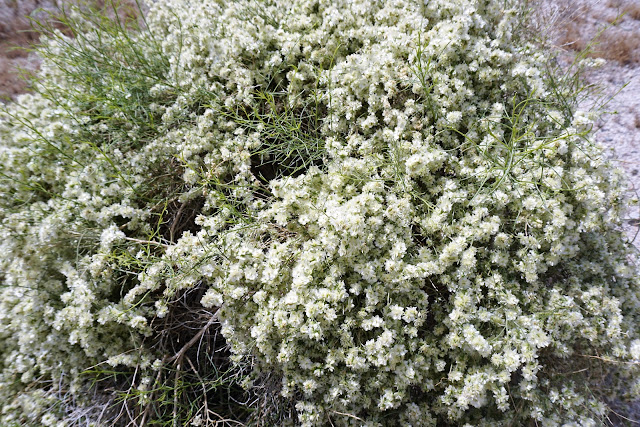I interrupt our Caribbean adventure posts with time sensitive material. In a week or two, the subjects of this post will disappear like Brigadoon, so I need to post about them now while they are still relevant.
When Bob asked me what I wanted to do for my birthday, I suggested going hunting for the Southern California Desert Super Bloom. We've had a record amount of rain this winter, and wildflowers are supposed to be putting on their best show in twenty years. My first choice would have been the Anza Borrego Desert, but it is over two hours away from where we live. Because I had a Saturday commitment, we could only go on a weekday, so Bob took a half day off on Friday and we drove to the high desert, only an hour away.
Of course, heading east on the 10 freeway mandates a stop in Cabazon at Hadley's for a date-banana shake. The shakes, along with a few other treats we bought there, served as our lunch:
After Hadley's we passed snow-capped Mt. San Jacinto:
. . . and field after field of electricity-generating windmills:
Eventually we arrived at the first of our two major stops: Chiriaco Summit, 1,705 feet above sea level.
Broad swaths of flat, windy desert are dotted with blooming ocotillo, one of my favorite desert plants. During the bloom season, the stalks are covered with green leaves and topped by mustaches of deep orange blooms:
Yellow brittlebush provides additional ornamentation:
The phrase "hair standing on end" comes to mind:
The same is true for the desert dandelions:
I dare you to pick these flowers blooming on top of a lethal barrel cactus:
An unknown bush adds a splash of snowy white:
Sacred datura also grows in the canyons around where we live, and I hear it has hallucinogenic properties:
I love the name of this one: popcorn flowers:
I'm not sure what this purple beauty is called, but I love the rich color:
The creosote bush has tiny powder puffs:
Desert landscapes are so dramatic. This tree looks like it is having a nervous breakdown:
Heading out of Chiriaco Summit, we could see fields of brittlebush in the distance, the California desert version of fields of Dutch tulips or French poppies or Scottish daffodils:
We bypassed the turnoff to Mecca/Twentynine Palms (No wonder our school kids don't know how to use hyphens) . . .
. . . and made our way to our second destination: Joshua Tree National Park.
Some of the trees are blighted by desert mistletoe, a parasitic plant that thrives in this area:
The brittlebush forms extra wide borders along the sides of the road:
These desert dandelions are more delicate that the lawn dandelions at my house, but they form the same feathery globe as they age:
I was surprised when Bob told me these spiky maroon balls are chia, the source of the nutritious seeds (and the infamous chia pets):
We started seeing more and more cacti, and most of them were in early bloom stages, like this silver cholla:
Try cuddling up to this cholla tonight:
And the award for Best Name goes to . . . . desert pincushion!

Bob has a thing for animal crossing signs. We stop for photos of them all over the world. He was excited about this one, but unfortunately we didn't see any actual bighorn sheep.
It's hard to top the deep pink roses that cover the beavertail cacti:
The beavertail "leaves" look almost devoid of prickly spines:
The silver cholla cactus more than makes up for the beavertail's lack of protection:
But the cholla blooms are just as stunning as the pink ones borne by the beavertail:
Some kind of desert daisy creeps almost unnoticed along the ground:
Hillsides are dappled with radiant yellows and greens:
The ocotillo is not really a cactus, although up close it looks like one:
In the spring, the thorny ocotillo stems are covered with waxy green leaves. Later in the year they will be bare and look dead. I love the twisted, tortured pattern formed by the grain of the wood:

The long, graceful branches end in flames of red flowers:
Bob's hand and camera provide perspective for the size of the blooms:
This almost-blooming branch looks like dozens of colored pencils:
The field of cactus looks like hundreds of lit torches, an effect caused by the light shining through the cactus quills:
Some views remind me more of a sci-fi forest--brown trunked trees with ethereal, glowing branches:
Everywhere I look I see beauty intertwined with pain, as in this hedgehog cactus
Those co-existing opposites are not so different from what we experience in our human lives:
The silver cholla will be beautiful in another week or so when those yellow buds are completely open:
Baby cholla are just as lethal as their parent plants. Dozens of single-orbed baby cacti cover some areas of the desert floor:
When you aren't watching (and even when you are), they jump off the ground and attach themselves to your shoe. Some of the quills are hooked on the end and can be difficult to extract. I told Bob that next time I'm bringing tweezers, but he suggested that pliers might be more effective:
Here is a parting shot of a Joshua tree, from which the park gets its name. According to legend, a group of Mormon settlers crossing the Mojave Desert in the mid 1800s thought the tree looked like the Biblical prophet Joshua reaching his hands to the sky in prayer, so they named the trees Joshua trees.
Next: Back to the Caribbean!













































































It was nice to see the desert in bloom, a nice present from desert Santa.
ReplyDeleteWhat an astonishing variety of desert flowers! Very beautiful.
ReplyDelete